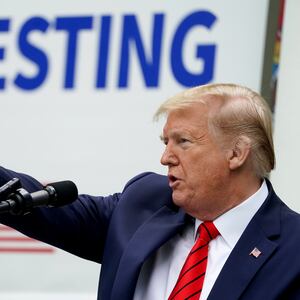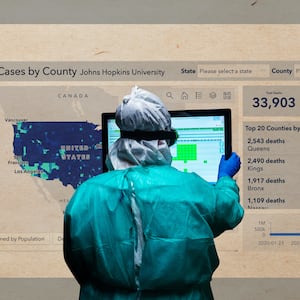President Donald Trump and members of his coronavirus task force are pushing officials at the Centers for Disease Control and Prevention to change how the agency works with states to count coronavirus-related deaths. And they’re pushing for revisions that could lead to far fewer deaths being counted than originally reported, according to five administration officials working on the government’s response to the pandemic.
Though he has previously publicly attested to the accuracy of the COVID-19 death count, the president in recent weeks has privately raised suspicion about the number of fatalities in the United States, which recently eclipsed 80,000 recorded deaths. In talks with top officials, Trump has suggested that those numbers could have been incorrectly tallied or even inflated by current methodology, two individuals with knowledge of those private comments said.
The White House has pressed the CDC, in particular, to work with states to change how they count coronavirus deaths and report them back to the federal government, according to two officials with knowledge of those conversations. And Deborah Birx, the coordinator of the administration’s coronavirus task force, has urged CDC officials to exclude from coronavirus death-count reporting some of those individuals who either do not have confirmed lab results and are presumed positive or who have the virus and may not have died as a direct result of it, according to three senior administration officials.
Officials inside the CDC, five of whom spoke to The Daily Beast, said they are pushing back against that request, claiming it could falsely skew the mortality rate at a time when state and local governments are already struggling to ensure that every person who dies as a result of the coronavirus is counted. Scientists and doctors working with the task force, including Anthony Fauci, the head of the National Institute of Allergy and Infectious Diseases, have said the U.S. death-toll count is likely higher than is being reflected in government data sets. And several local officials in hot spot areas said they’ve seen hundreds if not thousands more deaths over the last two months than in the same time period over the last several years. They presume many of those individuals contracted the coronavirus.
“I don’t worry about this overreporting issue,” Bob Anderson, the chief of the Mortality Statistics Branch in CDC’s National Center for Health Statistics, told The Daily Beast. Anderson’s team is in charge of aggregating, calculating, and reporting coronavirus deaths for the agency. “We’re almost certainly underestimating the number of deaths [in the country].”
The pressure being placed on the CDC is yet another tension point between the agency and the White House that has erupted over its handling of the coronavirus. Those tensions have reached a boiling point over the last several weeks as the CDC has worked to publish its guidelines for states working to reopen their local economies. The guidelines, which provide detailed information about how local officials can begin to allow some residents to attend religious gatherings and summer camps, were contested by White House officials who sought to shelve many of the agency’s recommendations.
The emerging fight over death counts represents a new front line in these battles—one that’s attracted the direct interest of the president himself. Though Trump has quietly suggested that the U.S. is inflating the COVID-19 death tolls, one task-force official told The Daily Beast that any discussion about mortality rate is merely a small part of a broader dialogue about how to improve the quality of data at the local, state, and federal level.
That official called the mortality rate a “far-lagging indicator” of the spread of the virus and argued that it was “not a real-time indicator of how the virus is affecting the population.” The official said it was the task force’s view that the mortality rate doesn’t “inform the response efforts as other data could, like hospitalizations” and that the virus moves through populations “like nursing homes and prisons,” as well as populations with comorbidities.
But according to other knowledgeable sources, there is broader skepticism within the White House over how the CDC is compiling its data. In a task-force meeting last week, officials relayed that Birx said she couldn’t trust the CDC’s numbers—on both case and death counts—because the reporting system it relied upon was flawed. She argued that the agency was likely overcounting. The Washington Post was the first to report on the meeting. Officials in the CDC said they were confused by the argument.
“The system can always get better. But if we’ve learned anything it’s that we’re seeing some of these individuals who have died of the virus slip through the cracks,” one official told The Daily Beast. “It’s not that we’re overcounting.”
But according to one of the sources with knowledge of Trump’s private remarks, the president recently said that he’d like a “review” of how the coronavirus deaths are counted and studied by the government, citing hypothetical cases in which a person has the virus but is killed by other unnatural means, such as falling down a flight of stairs. The other source said that Trump pointed out that death estimates for other incidents—such as natural disasters and wars—are revised down or up “all the time,” and that the coronavirus pandemic could have similar fluctuations in the numbers published by public and private entities. (This month, Axios was first to report on Trump voicing doubts behind closed doors about current body counts.)
It’s an argument that has gained traction in various pro-Trump circles, as well, and is mirrored by the complaints of some of the president’s closest advisers.
“My view is the president is totally correct that we need to have medical transparency,” said Art Laffer, a longtime conservative economist who has counseled Trump and other key administration officials on coronavirus response and how to “open” the economy amid the pandemic. “When you attribute a death to the coronavirus today, what that means is that the guy had the coronavirus and died. It doesn’t matter if he got hit by a car and died, and he would still be categorized as a coronavirus death... You need the whole transcribed medical records on a disk so people can sit there, maybe without names, and look for causes and correlations.”
Anderson said Laffer’s assessment was incorrect and that the form used by physicians to report coronavirus deaths specifically asks them to answer: “Did the patient die as a result of this illness?”
“It doesn’t say ‘Did this patient die?’” Anderson said.
Anderson’s division at the CDC keeps tabs on novel coronavirus deaths through two parallel tracking systems. It relies on the data it receives from local departments of health and through information it gathers from states through a death-certificate digital coding system.
Anderson said the death count is normally higher from states’ health systems than the death certificate system data. “But those numbers aren’t necessarily inconsistent,” he said, adding that the death-certificate death count usually lags anywhere from two to eight weeks. Meanwhile, local officials and doctors say any disruption in the way they count coronavirus deaths could lead to a significant undercounting.
One study by the New York City Department of Health and Mental Hygiene published Monday said that there were thousands of “excess deaths” in the city from March 11 to May 2. About 18,879 of those deaths were explicitly tied to the coronavirus. But the study said there were also an additional 5,200 that were not identified as either laboratory-confirmed or probable COVID-19-associated deaths, but could have been tied to the virus in some other way.
Gretchen Van Wye, the assistant commissioner of the Bureau of Vital Statistics at New York City Department of Health and Mental Hygiene, said her team matches individuals coded as having died from the coronavirus with the lab results to get a “confirmed” category of people daily. Then, with individuals that aren’t coded, the team uses an algorithm to search for words such as “Covid” or “Covid-19” on their death certificate to create a “probable” category. Unlike other cities across the country, New York City includes this probable count in its reporting. The rest of the results are considered as “other” deaths.
In New Jersey, officials told The Daily Beast that they have seen an uptick in the number of patients arriving at the hospital already deceased who were never tested for the virus. Two doctors—one in New York City and one in Jersey City—said that they have not tagged certain individuals as having died as a result of the coronavirus because families requested it be kept off the death certificate so they could more easily collect the remains.
Even with the death-certificate coding system, doctors and local officials say they are running into problems where some of their patients are not being counted in the total coronavirus death tally.
State officials are required to enter a specific code—a seven-digit number—on a death certificate to identify whether an individual has died as a result of COVID-19, Anderson said.
The CDC requires doctors to input “COVID-19” in order for an individual to be counted in the national system as having died as a result of the coronavirus. Several doctors in New York City who spoke with The Daily Beast said in high intensity situations human error could result in a physician not coding a patient correctly. Doctors were coding patients as simply “coronavirus” or some variation of that without indicating that the virus was specific to the 2020 pandemic. In some instances they were forgetting to input “-19” after “COVID”.
“Now we’re having to go back and recode those deaths,” Anderson said, adding that there were more than 1,500 individuals who were mistakenly overlooked in the first few weeks the CDC was calculating the coronavirus death count.










